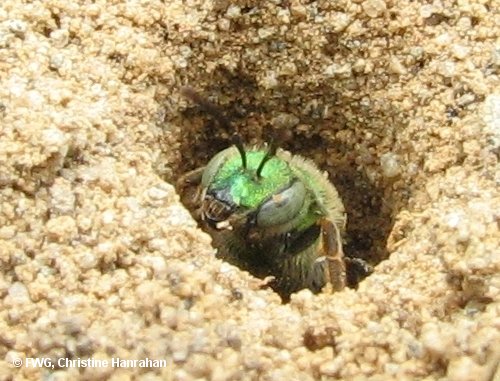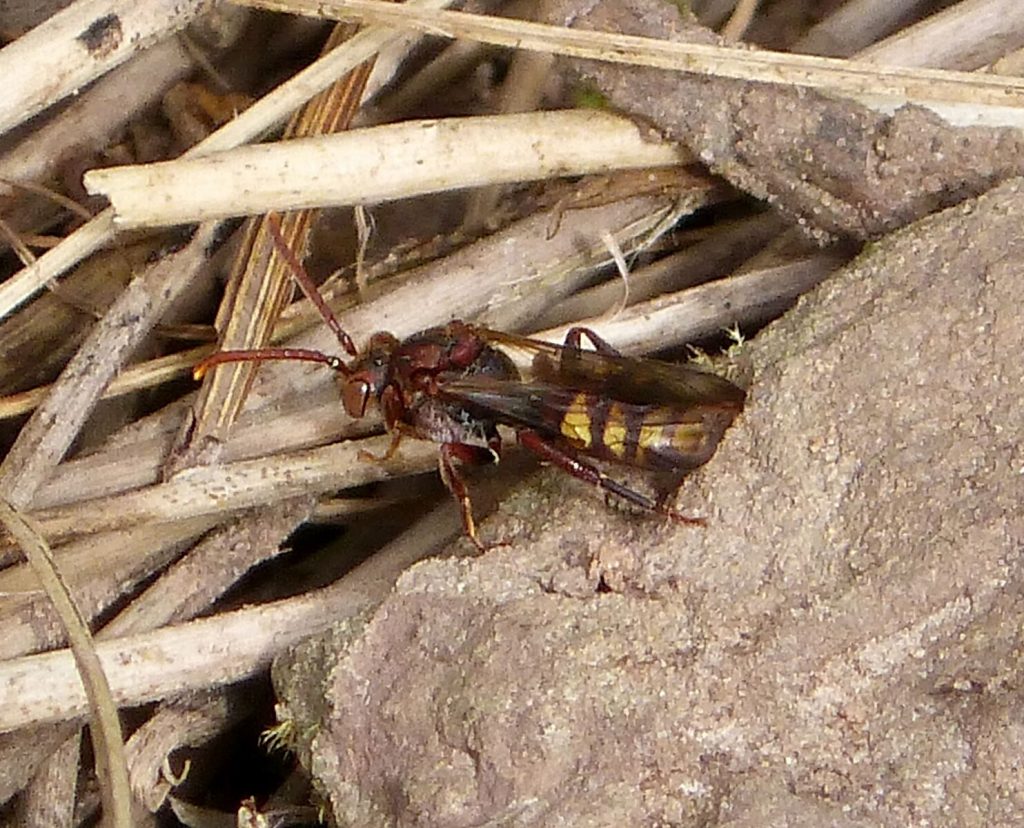By Nora Lee

Figure 1. An Halictid bee in the genus Agapostemon, guarding the entrance to a communal system of tunnels where other bees are laying eggs and provisioning them with pollen and nectar. Photo by Christine Hanrahan.
A bee is buzzing (or quietly zooming) around in the garden. We take its presence for granted. It appears in the periphery of our vision or we may pause to look more closely, but just to see what it looks like and what it might be doing before moving on with our activity.
But how often do we stop to think: where does it come from, where does it go? Indeed, this is important to know as we become more aware of our responsibility toward nature and our role in helping to preserve it. Knowing where and how bees and other insects live helps us understand how to help them survive and thrive and how to avoid interfering with their nests as much as possible.
There are a number of answers to where various bees live as well as how social they are. The former refers to the type and nature of nest and the latter to whether the bees live alone or in some sort of group system.
One thing that bees have in common is that they lay their eggs in little compartments that they construct (unless they are parasitic bees). These “cells” may be made in tunnels under ground, in tubular structures above ground, or in cavities. They can be made of all sorts of materials, depending on the bee. Bees’ common names often provide valuable clues about the nature of these materials, as we will see.
For many of us, the non-native honey bee is the model we see in our mind when we think of bees. But 70% of native bees in North America make their nests in tunnels underground, and the only other bees that make honey are bumble bees, and not in quantities that would lead to commercial exploitation.
By the way, the bees don’t all live in the nest. The males, especially, seldom do and have other places they hang out. This little article (BuzzAboutBees.net 2023) will fill you in on where bees sleep.
The WPP website includes a very helpful information sheet with lovely colour photos called Native Pollinators Info Sheet (Fiorindi 2019). This describes key characteristics of some common bees of Eastern Ontario. However, it doesn’t describe where they live so I thought I would focus, here, on these bees.
Family Apidae
The familiar Western Honey Bee, Apis melifera, makes cells in a honey comb structure out of wax it produces. These bees are not native to North America and are mostly housed here in man-made boxes. If a swarm escapes, however, it will set up house in the hollow of a tree or in an eave or even in the wall of a house if there is access from outside. They show up frequently in our gardens even in the city and may come from as much as 8 km away, although most foraging happens within 1 km of the hive. The negative impact on native bees of honey bees raised in cities has been in the news again recently as a result of a study done at Concordia University in Montréal (Lejtenyi 2023).
Bumble bees, genus Bombus, of which there are some 30 species in Eastern Canada (Packer et al. 2007), also make cells out of wax. Bumble bees like to make their nests at ground level preferring an existing burrow, such as one abandoned by another animal, with a shaded entry hole often hidden in a clump of grass or moss (Gammel 2020). Humans can take advantage of this preference by making nest containers for them. You can find instructions online for making nest containers out of wooden boxes or other materials and also on establishing a bumble bee colony.
Like honey bees, bumble bees are “eusocial” meaning the females share nests and food, and nest building and provisioning duties, and there is work specialization, similar to honey bees. However, their colonies are much smaller, numbering in the hundreds rather than thousands of members, and they exist for only one season. Only the queen bees overwinter to start the new colony the following year.
Small carpenter bees, Certina spp., as the common name suggests, make their nests in soft woody material: vertical, dead, pithy stems (Packer et al. 2007) or old dead twigs into which they have chewed holes from the top. They make cell divisions and the final plug with pulp made by chewing up pith.
These little critters are one of the reasons why we recommend leaving plant stems standing in the fall. This may look untidy, but fortunately there are ways to overcome that. You can either cut stems down to 12-15 inches in late fall and stow the cut stems, which may contain nests, somewhere sheltered in the garden to overwinter, or leave the cutting until the spring and then place the cut tops, which may still hold overwintering adults, somewhere in the garden to let them emerge when they are ready. Cutting stems to 12-15 inches tall allows nesting places for the spring round of nesting bees.
The wasp-like bees from the genus Nomada are kleptoparasites, meaning they lay their eggs in other bees’ nests, mainly those of Andrenidae, for their larvae to eat the food that the other bees have harvested (see Figure 4). They are not great pollinators as a result. Such parastic bees are often called cuckoo bees, after the birds that do the same thing.
Family Andrenidae
The genus Andrena from the family Andrenidae, known as mining bees, are largely solitary ground-nesting bees (Figure 5). They make tunnels in the ground, often preferring sandy soil, and line the cells with a waxy material that the bee produces. Although solitary, meaning that each bee female makes and provisions its own nest, some Andrenids build their nests in close proximity to others, i.e. in aggregations, sometimes quite close together (Embry 2020).
Family Halictidae
The Halictidae are the sweat bees, including the flashy metallic green sweat bees like Agapostemon. They are also ground nesting bees, for the most part, although some genera use holes in rotted wood above ground. Their social habit ranges from solitary to eusocial. They like dry compacted, bare soil and the holes are defined by little mounds, called tumuli (singular: tumulus) encircling them (Figure 6).
Another group of bees in the Halictidae family just known as sweat bees includes Halictus and Lasioglossum species. They have varying levels of sociality though are often in aggregations but certain species are eusocial, as well. Again, they mostly nest in the ground but a few species are known to nest in soft wood (Packer et al. 2007). The type of soil preferred varies from sandy in some cases (Gibbs 2014) to loam and other soil types (Antoine and Forrest 2020). In an interesting study, it was found that a loose layer of pebbles spread on the surface of the soil attracted many more Halictus rubicundus females to build nests compared to adjacent bare ground (Cane 2015).

Figure 8. Nest of halictid bee, Augochlora pura, under bark, and cell with larva. Briar Bush Nature Center, Montgomery County, Pennsylvania. Source: Wikimedia Commons
This same paper (Gibb, 2014) summarizes other research that shows many ground-nesting bees choose sites close to either stones or plants, particularly the ones they feed from, while others nest in expanses of bare ground. When looking around your garden for possible bee nests, these are additional clues about where to look.
Family Colletidae
The Colletidae or plasterer and cellophane bees are mainly solitary or have their nests in aggregations. They mainly nest in tunnels or holes in wood and stems and line their brood cells, as well as make their cell dividers, with a cellophane like material that they produce (Cole n.d.).

Figure 8. Cellophane bees are pollinators active in early spring. Each female makes a burrow in sandy or bare soil, and will provide her egg with a pollen ball. These bees are generally harmless, but you can discourage them from nesting in an area by overseeding. Source: (Wikimedia Commons)
Family Megachilidae
This family includes a diverse range of bee genera that use a variety of nesting matierals. Two genera that are common in our area are Osmia – mason and orchard bees, and Megachile – the leafcutter bees. Osmia get their mason nickname from their use of mud, chewed leaves and other materials to make their cell dividers and hole plugs. They are solitary nesters. They nest “in abandoned tunnels bored by beetles into living trees, in abandoned nests built by other genera of solitary bees, under bark, in abandoned wasp nests, underground, in hollow reeds or other plant stems, under rocks, in mud, in sand or dunes, and in snail shells” (Cane et al. 2007). Most of the species each just uses one type of material to create their brood cells.

Leafcutter bee nests. The two leaf columns are 17.5 and 19.5 cm in length and, together, bees used 403 leaf bits to build them. Each required a separate trip! – Photo by Subbu Subramanya Source. (Wikimedia Commons)
Lastly, here are a couple of bonus bees to learn about: the campus mining bee and the eight-spotted Perdita mining bee, both of the family Andrenidae – because I couldn’t resist sharing this fine article about them (Sharp and Eatman 2017).
References
- Antoine CM, Forrest JRK. 2020. Nesting habitat of ground-nesting bees: a review. Ecological Entomology 46(2): 143-159.
- Buzz About Bees. 2023. Do bees sleep?
- Cane JH. 2015. Landscaping pebbles attract nesting by the native ground-nesting bee Halictus rubicundus (Hymenoptera: Halictidae). Apidologie 46: 728–734.
- Cane JH, Griswold T, Parker FD. 2007. Substrates and materials used for nesting by North American Osmia bees (Hymenoptera: Apiformes: Megachilidae). Annals of the Entomological Society of America 100: 350-358.
- Cole E. n.d. Yellow-faced bee – Hylaeus. US Forest Service, Washington, DC.
- Embry P. 2018. Andrena: the mining bees. In Our Native Bees, Timber Press, Portland, Oregon.
- Fiorindi L. 2019. Native pollinators info sheet. Wild Pollinator Partners, Ottawa.
- Gammel EG. 2020. course notes from Fletcher Wildlife Garden’s pollinator garden workshop.
- Gibbs J. 2014. Sable Island sweat bee (Lasioglossum sablense): COSEWIC assessment and status report. Environment and Climate Change Canada, Ottawa.
- Lejtenyi P. 2023. Abundance of urban honeybees adversely impacts wild bee populations, according to new Concordia research. Concordia University, Montréal.
- Packer L, Genaro JA, and Sheffield CS. 2007. The bee genera of eastern Canada. Canadian Journal of Arthropod Identification 3.
- Sharp P, Eatman R. 2017. Panurginae mining bees: Calliopsis & Perdita. In ID Guide to Wild Bees – New York. Sharp-Eatman Nature Photography.
Nora Lee inherited her green thumb and sense of social responsibility from her mom but it was when she bought her own house, 26 years ago, that she started gardening in earnest. Besides filling all the spaces in and around her own garden, she also founded and designed the Clyde Bee & Butterfly Patch pollinator garden in 2020, bringing in neighbourhood volunteers to help grow plants, and plant and water them.





